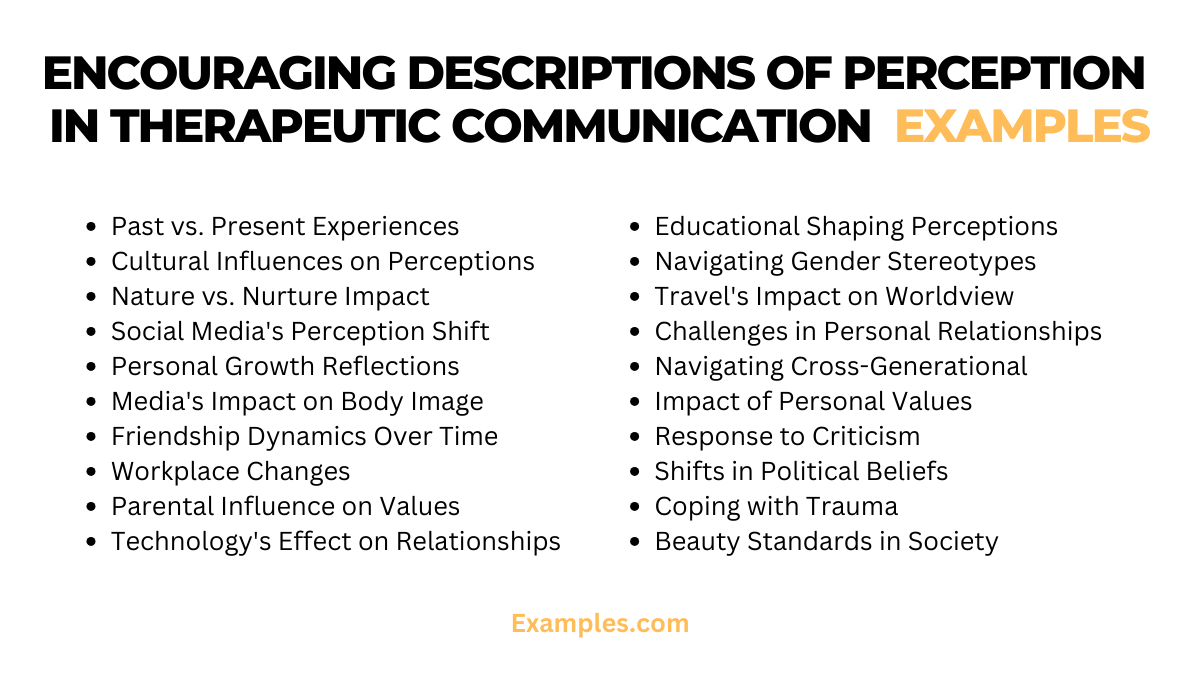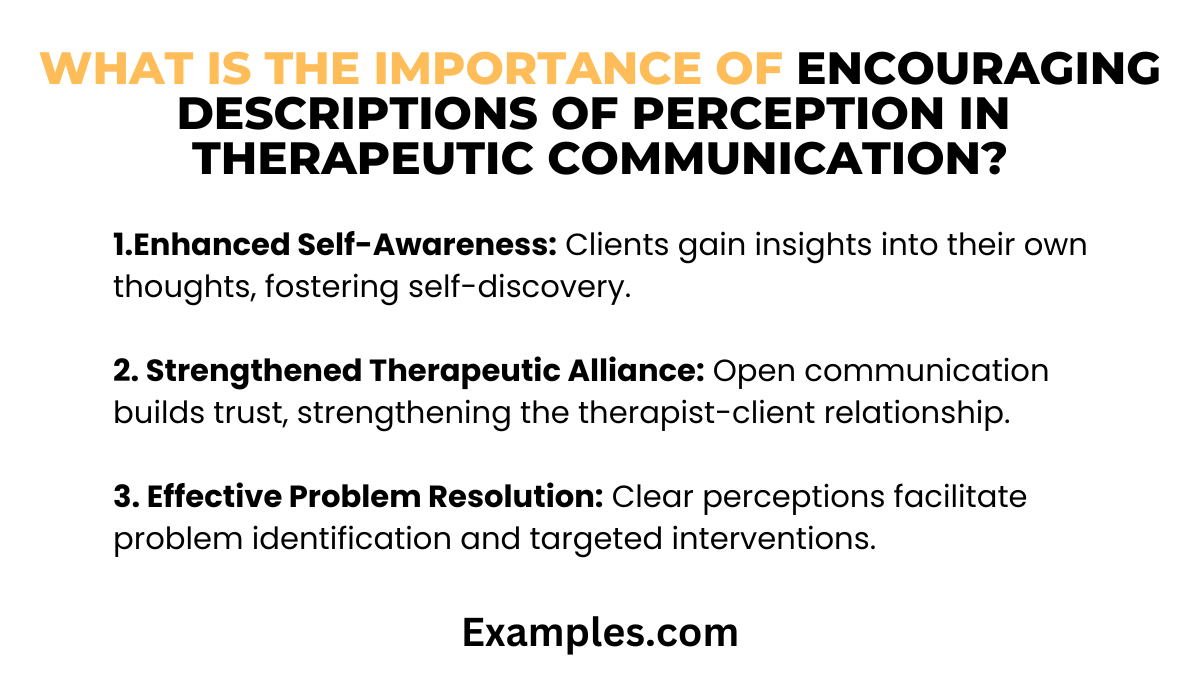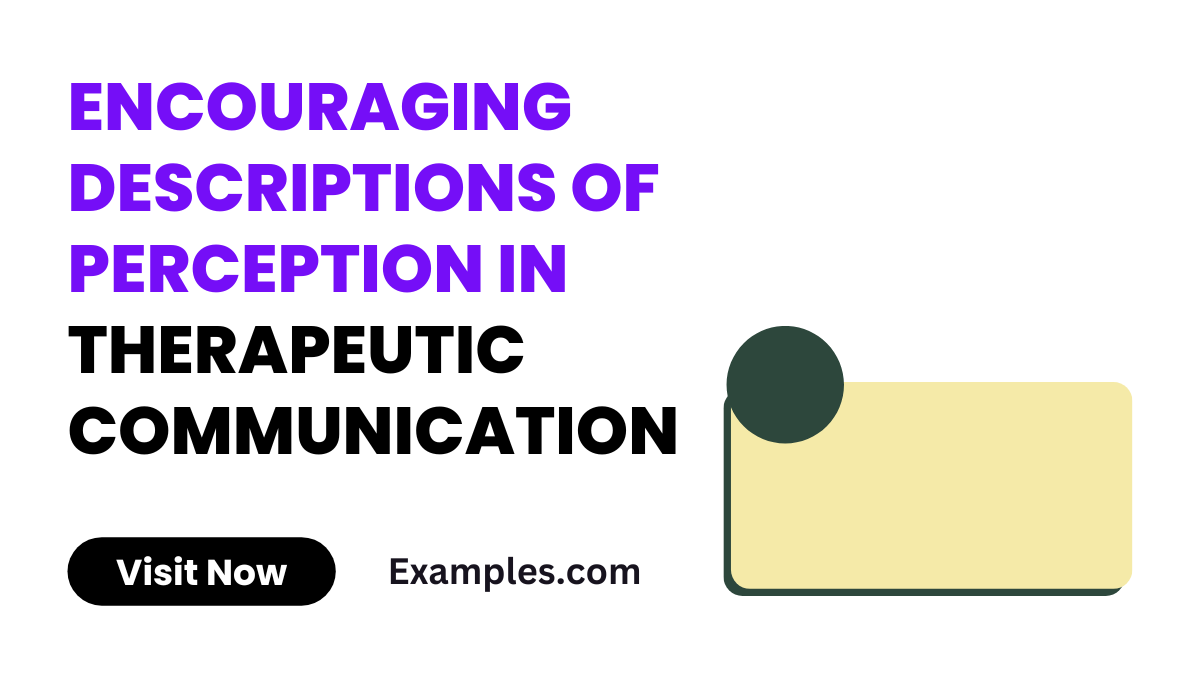19+ Encouraging Descriptions of Perception in Therapeutic Communication Examples
Dive into the transformative realm of Encouraging Descriptions of Perception in Therapeutic Communication. Uncover a comprehensive guide infused with practical communication examples that illuminate the art of perceptive dialogue. Elevate your therapeutic skills, employing nuanced perceptions to enhance empathetic connections and foster profound understanding. This guide unveils expert strategies and real-world instances, empowering you to navigate the complexities of therapeutic interactions with finesse. Enhance your communication prowess and embark on a journey of empathetic exploration with our insightful guide.
What is Encouraging Descriptions of Perception in Therapeutic Communication?

Encouraging Descriptions of Perception involve fostering open dialogue where individuals express their unique perspectives, feelings, and experiences. In therapeutic communication, this technique nurtures understanding by encouraging detailed and perceptive descriptions of one’s thoughts and emotions. By facilitating a deeper exploration of perceptions, individuals can build stronger connections, and therapists can gain valuable insights into their clients’ inner worlds, fostering a more empathetic and collaborative therapeutic relationship.
20 Encouraging Descriptions of Perception in Therapeutic Communication Examples

Understanding an individual’s unique perspective is crucial in therapeutic communication. Employing encouraging descriptions of perception fosters deeper connections. Here are examples:
- Past vs. Present Experiences: Express how past experiences shape your current perceptions, creating a comprehensive self-narrative.
- Cultural Influences on Perceptions: Share cultural insights influencing your perceptions to enhance cross-cultural understanding in therapy.
- Nature vs. Nurture Impact: Discuss how nature and nurture contribute to your perceptions, unraveling the complexity of influences.
- Social Media’s Perception Shift: Explore how social media alters your perceptions, affecting self-image and interpersonal dynamics.
- Personal Growth Reflections: Reflect on personal growth, emphasizing the evolving nature of perceptions through transformative experiences.
- Media’s Impact on Body Image: Describe how media shapes your perception of body image, contributing to self-esteem and societal expectations.
- Friendship Dynamics Over Time: Examine how your perceptions of friendship dynamics evolve, impacting expectations and emotional connections.
- Workplace Changes: Discuss changing workplace perceptions, addressing how roles, responsibilities, and colleagues influence your outlook.
- Parental Influence on Values: Share how parental values influence your perceptions, contributing to your ethical and moral framework.
- Technology’s Effect on Relationships: Explore how technology impacts your perceptions of relationships, considering virtual interactions and communication.
- Educational Experiences Shaping Perceptions: Delve into educational encounters that shape your perceptions, influencing learning styles and academic outlook.
- Navigating Gender Stereotypes: Describe experiences navigating gender stereotypes, shaping perceptions of identity and societal expectations.
- Travel’s Impact on Worldview: Discuss how travel experiences shape your worldview, broadening cultural understanding and perspectives.
- Challenges in Personal Relationships: Share insights into challenges faced in personal relationships, unveiling perceptions and coping mechanisms.
- Navigating Cross-Generational Communication: Express challenges and growth in cross-generational communication, understanding diverse perspectives.
- Impact of Personal Values: Examine how personal values mold perceptions, influencing decision-making and interpersonal interactions.
- Response to Criticism: Illustrate how your perceptions guide responses to criticism, showcasing self-awareness and adaptability.
- Shifts in Political Beliefs: Explore shifts in political beliefs, emphasizing the dynamic nature of perceptions in a changing socio-political landscape.
- Coping with Trauma: Share coping mechanisms developed to navigate trauma, emphasizing the resilience embedded in altered perceptions.
- Beauty Standards in Society: Discuss societal beauty standards and their impact on self-perception, promoting body positivity and self-acceptance.
Encouraging Descriptions of Perception in Therapeutic Communication Examples for Patients
In therapy, patients explore past experiences, cultural influences, and personal growth, shaping unique perceptions. Therapists facilitate discussions, emphasizing self-awareness and adapting coping mechanisms.
- Coping with Trauma: “Reflect on coping strategies. Share insights into trauma, fostering resilience in altered perceptions.”
- Navigating Personal Relationships: “Explore relationship challenges. Unveil perceptions, fostering understanding and adaptive communication strategies.”
- Impact of Health on Perception: “Discuss health’s impact on perceptions. Share experiences, promoting self-awareness and adaptive coping mechanisms.”
- Reflections on Identity: “Reflect on personal identity. Explore influences, fostering a deeper understanding and acceptance of oneself.”
- Navigating Cultural Influences: “Discuss cultural insights. Enhance cross-cultural understanding, fostering awareness and appreciation of diverse perspectives.”
What are Encouraging Descriptions of Perception in Therapeutic Communication Techniques?
Encouraging descriptions of perception in therapeutic communication involve specific strategies to facilitate understanding and expression. Techniques include:
- Reflective Listening: Actively listen and mirror the client’s expressions, fostering a sense of being heard.
- Open-Ended Questions: Encourage clients to share detailed perceptions, promoting deeper exploration.
- Empathetic Responses: Convey understanding and empathy, validating the client’s emotional experience.
- Paraphrasing: Rephrase the client’s thoughts to reinforce understanding and encourage further elaboration.
- Cultural Sensitivity: Acknowledge and respect diverse cultural perspectives, promoting inclusivity.
- Body Language Awareness: Be attuned to nonverbal cues, enhancing perception comprehension.
What is the Importance of Encouraging Descriptions of Perception in Therapeutic Communication?

Encouraging descriptions of perception hold immense significance in therapeutic communication for several reasons:
- Enhanced Self-Awareness: Clients gain insights into their own thoughts, fostering self-discovery.
- Strengthened Therapeutic Alliance: Open communication builds trust, strengthening the therapist-client relationship.
- Effective Problem Resolution: Clear perceptions facilitate problem identification and targeted interventions.
- Emotional Expression: Clients can articulate emotions, promoting emotional well-being and understanding.
- Cultural Competence: Acknowledging diverse perceptions fosters culturally competent and inclusive therapy.
How Encouraging Descriptions of Perception in Therapeutic Communication Helpful?
Encouraging descriptions of perception contribute to the overall efficacy of therapeutic communication by:
- Promoting Autonomy: Clients feel empowered to express individual perspectives, promoting autonomy.
- Addressing Misunderstandings: Clear descriptions minimize misinterpretations, enhancing communication accuracy.
- Facilitating Emotional Processing: Clients navigate and process emotions effectively through articulated perceptions.
- Building Resilience: Reflecting on perceptions encourages resilience, contributing to personal growth.
- Encouraging Positive Change: Therapists can guide clients toward positive changes by understanding and addressing perceptions.
Tips for Effective Encouraging Descriptions of Perception in Therapeutic Communications
- Active Listening: Engage in attentive and nonjudgmental listening to understand clients’ perspectives fully.
- Empathetic Responses: Convey empathy by acknowledging and validating clients’ emotions and perceptions.
- Open-Ended Questions: Encourage clients to elaborate on their thoughts with questions that prompt detailed responses.
- Reflective Techniques: Use reflective techniques, such as paraphrasing, to mirror clients’ expressions for clarity.
- Cultural Sensitivity: Be aware of cultural nuances, ensuring inclusivity and respect for diverse perceptions.
- Nonverbal Cues: Pay attention to nonverbal cues, as they offer valuable insights into clients’ unspoken emotions.
- Clarification: Seek clarification when needed, ensuring accurate understanding and preventing misinterpretations.
- Feedback Loop: Establish a feedback loop where clients confirm that their perceptions have been accurately understood and addressed.
In conclusion, embracing the diverse narratives within therapeutic communication, specifically through encouraging descriptions of perception, fosters self-awareness and understanding. This comprehensive guide illuminates the importance of exploring past experiences, cultural influences, and personal growth. By navigating these aspects, individuals can develop adaptive coping mechanisms, unravel the complexities of their influences, and embark on a journey towards enriched self-perception and interpersonal connections.



